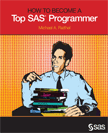Occasionally, people ask me what is the best thing about writing a book. Is it the notoriety you get from being a SAS Press author? Fame is always pleasant. Is it the money you make from the advance and the royalties? Money is always useful. Is it displaying technical expertise on a facet of SAS programming? SAS proficiency is always important. Is it being invited to give presentations at SAS users groups? Being included is always nice. But, none of those are really the most rewarding aspects of writing a SAS book.
Here is my top 10 list of the most gratifying moments when writing a SAS book:
10. Realizing that you have enough information to write a book. It is a great feeling when you realize that you have a critical mass of material and expertise in a particular facet of SAS programming. You can either hoard that knowledge or share it with fellow SAS professionals.
9. Sending your book proposal to SAS Press. It is a big step to go from simply thinking about writing a book to actually deciding to write one. You create your book outline, fill out the book proposal form, and send the package to SAS Press for consideration. Once you do, it feels a lot like you are holding a lottery ticket waiting for a big jackpot.
8. Receiving a book contract from SAS Press. Receiving a book contract feels like all of your favorite holidays and your birthday arrived on the same day! It is a validation that your ideas were sound and will appeal to a wider audience of SAS professionals.
7. Sending your first 3 chapters to SAS Press. Most contracts require that you send the first three chapters in first, so the editors can verify you are on the right track. It feels great to have the first piece of your new work heading off to the editors.
6. Sending your first draft to SAS Press. It is a huge relief to have the complete first draft of your book in a cogent, well-organized form off of your desk and into the hands of SAS Press. You can take a well-deserved rest after the intense creative process of writing new material.
5. Completing your edits and sending your edited manuscript to SAS Press. You received your manuscript back with lots of helpful suggestions for changes from knowledgeable technical and content editors. After a couple of months of revisions, you have addressed technical issues and tightened up your manuscript. Now, it is going back to the editors and you can relax again.
4. Completing the copy edits. The copy editing phase involves receiving a copy of your work laid out in book format with suggestions for better wording and structure. Once this phase is completed, you are pretty well close to being published.
3. Receiving your copies of the published book. All of the toil that went into the book is forgotten when you hold it in your hands for the first time and leaf through it. You enjoy how well-written it is and the professional look the book has.
2. Autographing your first copy of the published book. It is an absolute thrill to have a SAS user ask you to sign a copy of your book.
1. A SAS professional telling you how your book saved his/her life. There is no better feeling than having a SAS professional tell you that your book made a significant difference in the work s/he was doing. This is the ultimate validation that you made the right choice in deciding to write the book.
 Notoriety, money, technical expertise, and invitations are all very good. But, the real reward in writing a book for SAS Press—as in a lot of other endeavors in life—is being able to help other people.
Notoriety, money, technical expertise, and invitations are all very good. But, the real reward in writing a book for SAS Press—as in a lot of other endeavors in life—is being able to help other people.
Learn more about Michael Raithel and his work, including his forthcoming book How to Become a Top SAS Programmer.

1 Comment
Well, I am working on a proposal...... Since it's a statistics book I have to send the first chapter in with the proposal.
Peter